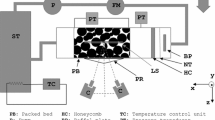Abstract
Stereoscopic digital Particle Image Velocimetry (PIV) has been used to make a three-dimensional flow mapping of a volume of approximately 0.1 × 0.1 × 0.15 m in a laboratory model electrostatic precipitator (ESP). The mapped volume covers about two unit cells determined by the 100 mm electrode spacing in the 0.2 × 0.2 × 1.0 m ESP test section of the negative corona, barbed wire, smooth-plate kind. The barbs act as corona fix points, yielding a three-dimensional electrostatic field. The induced large-scale secondary gas velocity structures in the form of unsteadily undulating axial rolls have been analyzed for swirlnumber and location of instantaneous swirl center in 11 axial planes. The flow possesses high levels of turbulence and axial vorticity. Measured particle velocities are corrected for electrical drift to produce gas velocities. Subsequently experimental results are compared to Large Eddy Simulation (LES) results.
Similar content being viewed by others
References
Adrian, R.J., Particle-imaging techniques for experiments in fluid mechanics. Ann. Rev. Fluid Mech. 23 (1991) 261–304.
Adrian, R.J. and Yao, C.-S., Pulsed laser technique application to liquid and gaseous flows and the scattering power of seed materials. Appl. Opt. 24(1) (1985) 44–52.
Armendariz, A.J. and Leith, D., Concentration measurement and counting efficiency for the aerodynamic particle sizer 3320. J. Aerosol Sci. 33 (2002) 133–148.
Cochet, R., Théorie de la charge des particules submicroniques dans les champs électriques ionises; vitesse de précipitation de ces particules. Acad. Sci. C. R. Hebdomadaires des Séances 243 (1956) 243–246.
Davidson, J.H., Particulate space charge induced turbulence in gas-solid flows with an applied electric field. ASME Fluids Engrg. Div. 76 (1989) 65–71.
Davidson, J.H. and Shaughnessy, E.J., Turbulence generation by electric body forces. Exp. Fluids 4 (1986) 17–26.
Graftieaux, L., Michard, M. and Grosjean, N., Combining PIV, POD and vortex identification algorithms for the study of unsteady turbulent swirling flows. Meas. Sci. Technol. 12 (2001) 1422–1429.
Kallio, G.A. and Stock, D.E., Interaction of electrostatic and fluid dynamic fields in wire-plate electrostatic precipitators. J. Fluid Mech. 240 (1992) 133–166.
Lama, W.L. and Gallo, C.F., Systematic study of the electris characteristic of the -Trichel-current pulses from negative needle to plane coronas. J. Appl. Phys. 45 (1974) 103–113.
Larsen, P.S. and S-rensen, S.K., Effect of secondary flows and turbulence on electrostatic precipitator efficiency. Atmos. Env. 18 (1984) 1963–1967.
Lê, T.H., Troff, B., Sagaut, P., Dang-Tran, K. and Phuoc, L.T., PEGASE: A Navier-Stokes solver for direct numerical simulation of incompressible flows. Internat. J. Numer. Methods Fluids 24 (1997) 833–861.
Lenormand, E., Sagaut, P., Phuoc, L.T. and Comte, L.P., Subgrid-scale models for large-eddy simulations of compressible wall bounded flows. AIAA J. 38 (2000) 1340–1350.
Leonard, G.L., Mitchner, M. and Self, S.A., An experimental study of the electrohydrodynamic flow in electrostatic precipitators. J. Fluid Mech. 127 (1983) 123–140.
Lide, D.R. (ed.), Handbook of Chemistry and Physics, 76th edn. National Institute of Standards and Technology (1995) pp. 12–52.
Prasad, A.K., Stereoscopic particle image velocimetry. Exp. Fluids 29 (2000) 103–116.
Riehle, C., Basic and theoretical operation of ESPs. In: Parker, K.R. (ed.), Applied Electrostatic Precipitation. Blackie Academic & Professional (1997) pp. 85–88.
Sagaut, P., Montreuil, E. and Labbe, O., Assessment of some self-adaptive SGS models for wall bounded flows. Aerosp. Sci. Tech. 6 (1999) 335–344.
Soldati, A. and Banerjee, S., Turbulence modification by large-scale organized electrohydrodynamic flows. Phys. Fluids 10(7) (1998) 1742–1756.
Ullum, T., Larsen, P.S. and Özcan, O., Three-dimensional flow and turbulence structure in electrostatic precipitator by stereo PIV. Exp. Fluids 36 (2004) 91–99.
Van de Hulst, H.C., Light Scattering by Small Particles. Dover Publications, Oxford (1981).
Westerweel, J., Fundamentals of digital particle image velocimetry. Meas. Sci. Technol. 8 (1997) 1379–1392.
Yamamoto, T. and Velkoff, H.R., Electrohydrodynamics in an electrostatic precipitator. J. Fluid Mech. 108 (1981) 1–18.
Zamany, J., Modeling of particle transport in commercial electrostatic precipitators. Ph.D. Thesis, Technical University of Denmark (1992).
Zamany, J., Influence of charge diffusion on the induced electro-hydrodynamic field inside electrostatic precipitators. Inst. Phys. Conf. Ser. 143 (1995) 69–74.
Author information
Authors and Affiliations
Rights and permissions
About this article
Cite this article
Ullum, T., Larsen, P.S. Swirling flow structures in electrostatic precipitator. Flow Turbulence Combust 73, 259–275 (2005). https://doi.org/10.1007/s10494-005-6772-9
Received:
Accepted:
Issue Date:
DOI: https://doi.org/10.1007/s10494-005-6772-9




